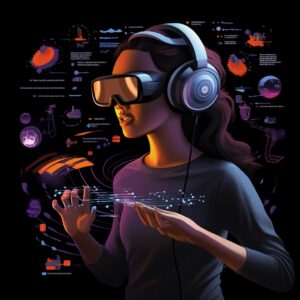AR in Education: Engaging Interactive Learning
Augmented Reality (AR) in education has the potential to revolutionize traditional teaching methods by providing engaging and interactive learning experiences. Here are several ways in which AR can be utilized to enhance education:
- Immersive Learning Environments:
- To begin with, AR can create virtual environments that simulate real-world scenarios, allowing students to explore and interact with concepts in a more immersive way. For example, history students can “walk through” historical events or biology students can explore the human body in 3D.
- Interactive Textbooks:
- Furthermore, AR can bring static textbooks to life by overlaying digital content on printed pages. Consequently, students can access additional information, videos, or interactive simulations by scanning the pages with a mobile device, making learning more dynamic and engaging.
- 3D Models and Simulations:
- Moreover, in complex subjects like anatomy, chemistry, or physics, AR can be instrumental in creating 3D models and simulations. These simulations can be projected into the real world, allowing students to manipulate and interact with them, fostering a deeper understanding of abstract concepts.
- Virtual Laboratories:
- Additionally, in science and engineering disciplines, AR can simulate laboratory environments. By doing so, students can conduct experiments in a virtual space, reducing costs, mitigating safety concerns, and providing access to experiments that may not be possible in a traditional classroom.
- Language Learning:
- In language learning, AR can enhance the experience by overlaying translations, phonetic guides, or interactive exercises onto real-world objects. This creates a more immersive language-learning experience, helping students associate words and phrases with real-world context.
- Historical and Cultural Exploration:
- Beyond this, history and geography lessons can benefit from AR by allowing students to virtually explore historical sites, ancient civilizations, or cultural landmarks. Consequently, this firsthand experience can make learning about different cultures and historical events more engaging.
- Collaborative Learning:
- Moreover, AR fosters collaboration among students. Shared AR experiences enable collaborative problem-solving and group projects. As a result, students can work together in augmented spaces, sharing information and collaborating on projects in real time.
- Gamified Learning:
- Additionally, incorporating game elements into educational content can make learning more enjoyable and effective. Specifically, AR games can be designed to teach various subjects, turning the learning process into a fun and interactive experience.
- Field Trips from the Classroom:
- In an innovative approach, AR can virtually transport students to different locations around the world. Consequently, this provides virtual field trips without leaving the classroom, which is particularly beneficial for schools with budget constraints or logistical challenges.
- Adaptive Learning:
- Last but not least, AR applications can adapt to individual learning styles and paces, providing personalized content and feedback. Consequently, this ensures that students receive the support they need, making education more inclusive and effective.
In conclusion, AR in education has the potential to engage students in ways that traditional methods cannot. By creating interactive and immersive learning experiences, AR can make education more enjoyable, effective, and accessible for a wide range of learners.




